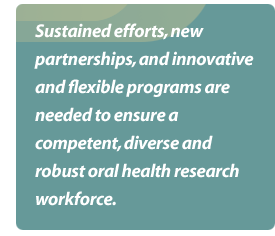

Research and Professional Workforce
Adequately trained professionals are the lifeblood of dental education, practice and research. Oral health researchers, educators, and practitioners should  reflect the diversity of America and have the broad mix of skills needed to address complex oral, dental and craniofacial diseases and conditions. However, the research and professional dental workforce does not adequately represent the composition of the U.S. population. Data show that underrepresented minority dentists play a large role in increasing access to underserved and minority populations, can influence other health professionals to be more culturally sensitive, and serve as powerful role models to other minorities and to would-be educators or researchers. The challenges here include addressing the inadequate number of underrepresented minorities in all aspects of dentistry, addressing the critical shortage of clinical researchers, and developing researchers who will be familiar with knowledge and methods from a variety of disciplines. In terms of diversity, the magnitude of the challenge is perhaps best expressed by looking at the “pipeline,” or the number of underrepresented minority dentists and students in U.S. dental schools. African Americans account for 12.9 percent of the general population but only 2.2 percent of active dentists and less than 5 percent of students enrolled in dental schools. Hispanics comprise 12.5 percent of the population but only 2.8 percent of active dentists and 5.3 percent of enrolled dental students in 1999–2000. Most troubling perhaps is the 15 percent decline in the number of underrepresented minority first-year students in dental schools since 19906. While enrollment of women in dental schools is increasing, they are underrepresented in academics and research. Sustained efforts, new partnerships, and innovative and flexible programs are needed to ensure a competent, diverse and robust oral health research workforce. These critical national needs are identified in the Surgeon General’s report on oral health and in the National Oral Health Call to Action.
reflect the diversity of America and have the broad mix of skills needed to address complex oral, dental and craniofacial diseases and conditions. However, the research and professional dental workforce does not adequately represent the composition of the U.S. population. Data show that underrepresented minority dentists play a large role in increasing access to underserved and minority populations, can influence other health professionals to be more culturally sensitive, and serve as powerful role models to other minorities and to would-be educators or researchers. The challenges here include addressing the inadequate number of underrepresented minorities in all aspects of dentistry, addressing the critical shortage of clinical researchers, and developing researchers who will be familiar with knowledge and methods from a variety of disciplines. In terms of diversity, the magnitude of the challenge is perhaps best expressed by looking at the “pipeline,” or the number of underrepresented minority dentists and students in U.S. dental schools. African Americans account for 12.9 percent of the general population but only 2.2 percent of active dentists and less than 5 percent of students enrolled in dental schools. Hispanics comprise 12.5 percent of the population but only 2.8 percent of active dentists and 5.3 percent of enrolled dental students in 1999–2000. Most troubling perhaps is the 15 percent decline in the number of underrepresented minority first-year students in dental schools since 19906. While enrollment of women in dental schools is increasing, they are underrepresented in academics and research. Sustained efforts, new partnerships, and innovative and flexible programs are needed to ensure a competent, diverse and robust oral health research workforce. These critical national needs are identified in the Surgeon General’s report on oral health and in the National Oral Health Call to Action.
Developing and Enhancing Key Research Infrastructure
Strong research-oriented academic environments are needed to develop the intellectual talent for research, and to enable existing investigators to acquire and expand their skills in new areas of science. Oral health research can be carried out in a number of settings including dental schools, different components of academic health centers, hospitals and independent research institutions. The capacity of dental schools to conduct research and to serve as training grounds for future investigators is key to the future of clinical and applied oral health research. However, major barriers must be overcome. These include a critical shortage of faculty, a lack of integration between the basic and clinical sciences in pre-doctoral programs, inadequate incorporation of research into the dental curriculum, and financial shortfalls. Research, while exceptionally strong in some dental schools, is almost non-existent in others. Between 50 to 60 percent of NIDCR research support is concentrated in ten of the 55 U.S. dental schools. Substantial investments will be needed to bolster U.S. dental schools’ research infrastructure and to ensure a workforce that is adequate both in numbers and in its ability to address the changing scientific needs.
Further advancements in science will require continued developments in technology, computer power, and analytic methods. New large databases and mathematical methods will be required to catalogue, organize and understand vast amounts of information generated from the sequence of genes or proteins. The NIDCR Scientific Expert Panel on Genomics and Proteomics highlighted the need for significant development in bioinformatics, and for creating “new algorithms to analyze and interpret the data and ways to visualize and present genomic information to researchers.” The panel also suggested a number of strategies that NIDCR could pursue to make resources available to researchers and share the cost of expensive technology development.
6Valachovic RW, Weaver RG, Sinkford JC, Haden NK. Trends in dentistry and dental education. Journal of Dental Education: June 2001; 65(6):539-561.


